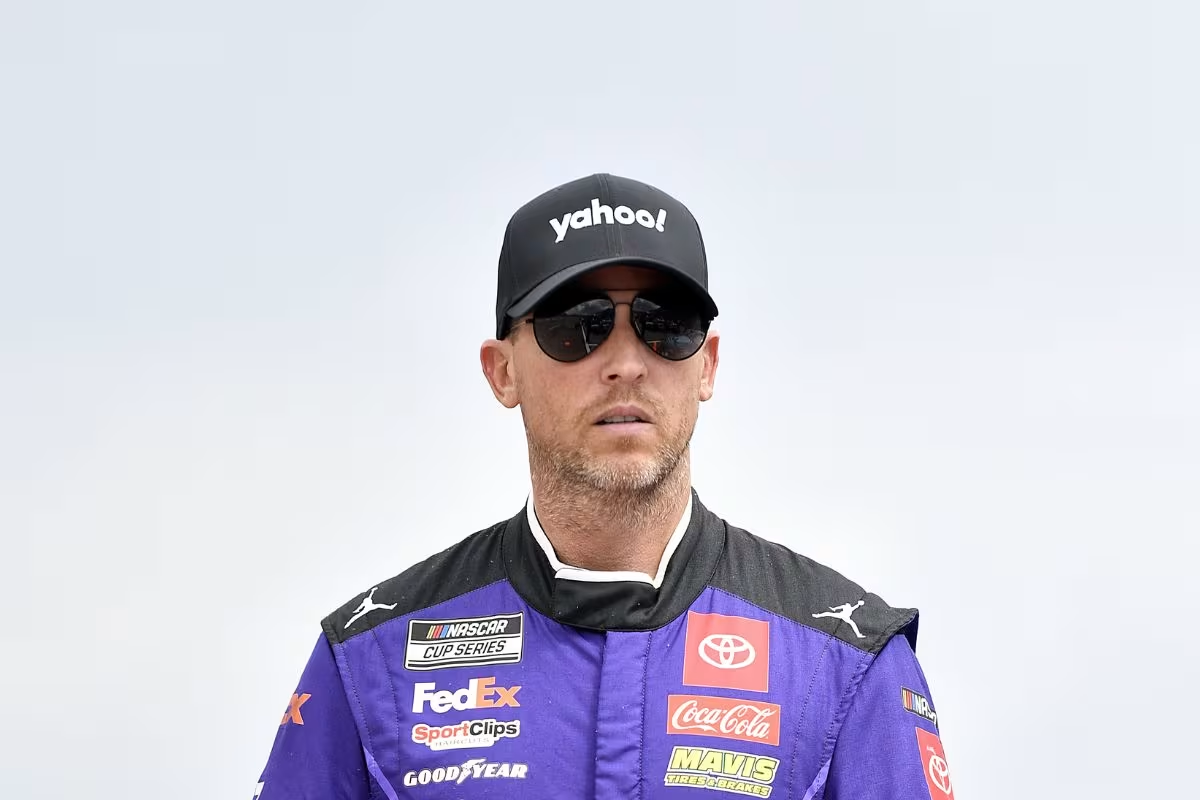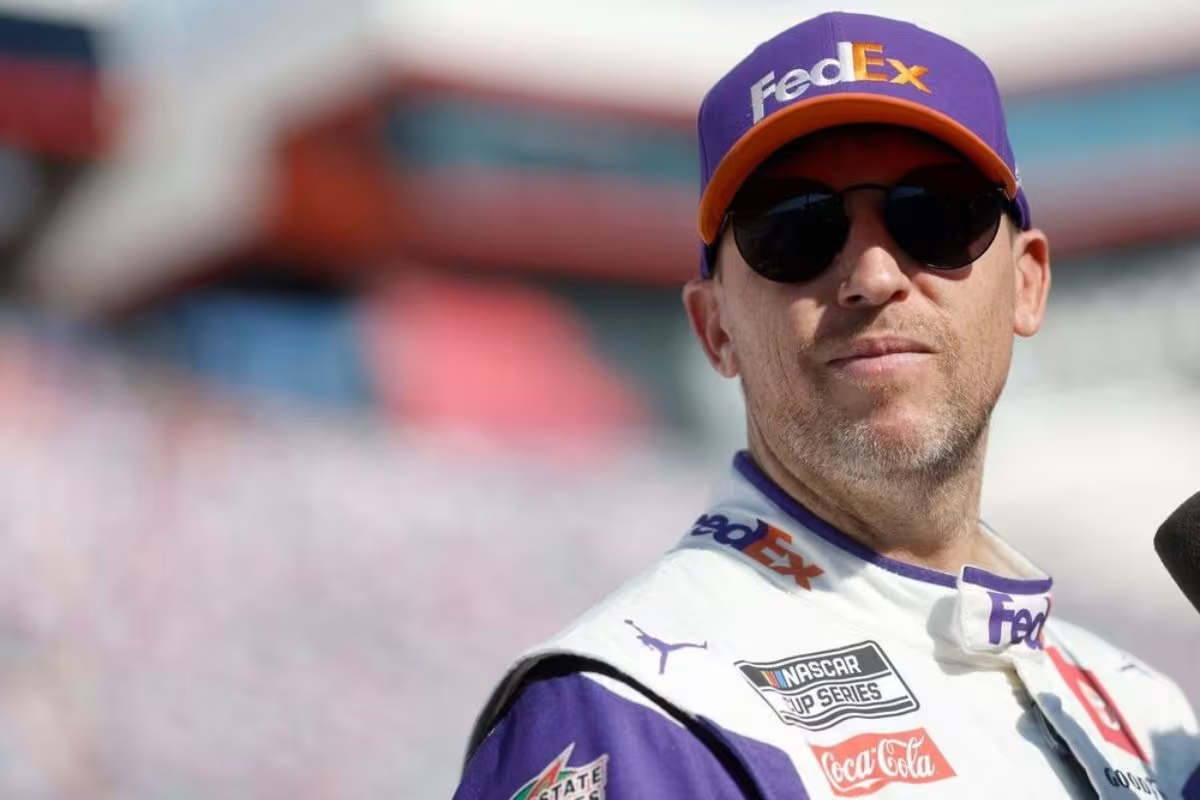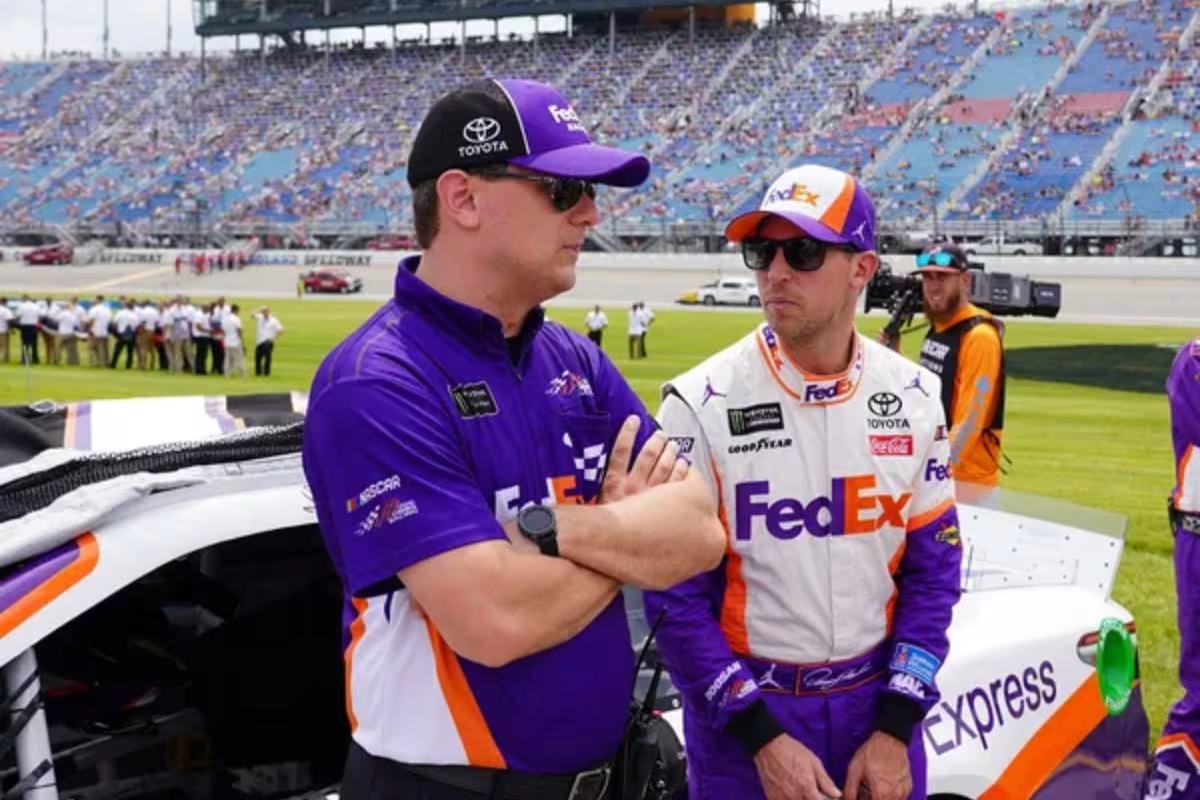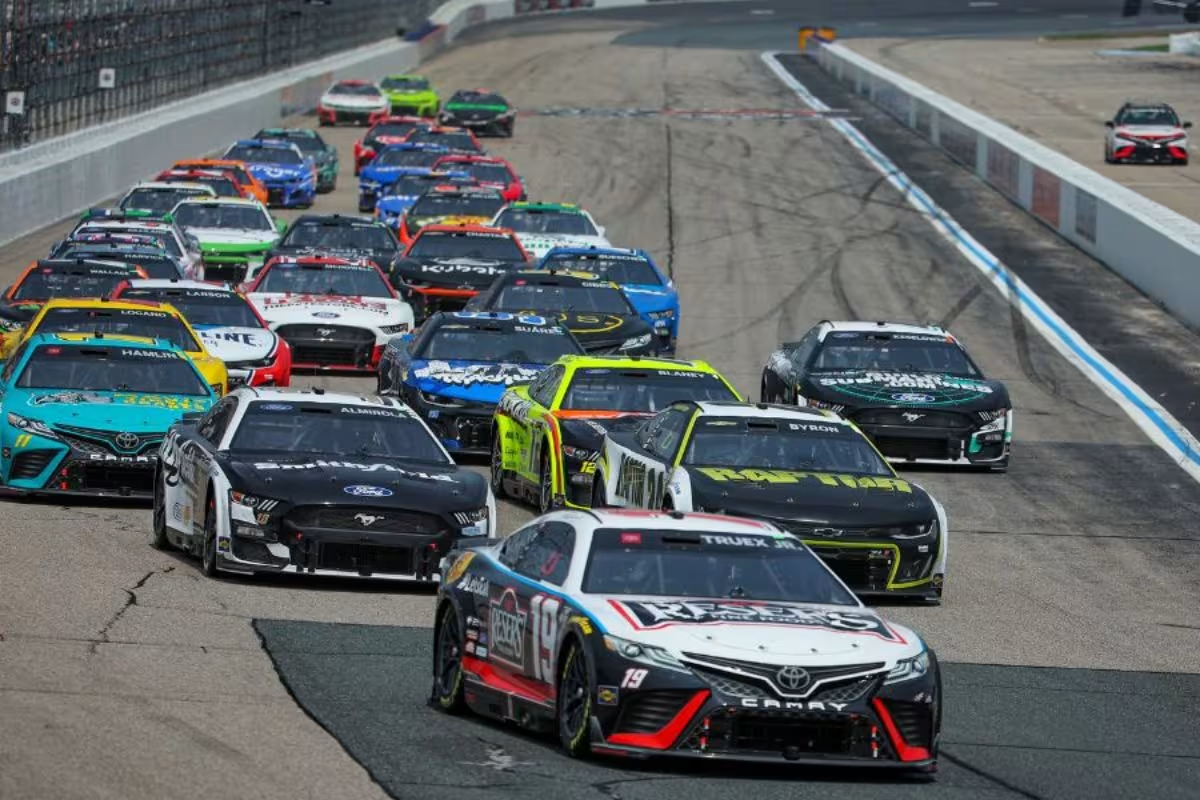Denny Hamlin‘s pit road blunder at Las Vegas proved costly, as his slow stop of 13.4 seconds led to a notable drop from fifth to 14th position. This error not only affected his race outcome—he finished eighth—but it raised serious questions about his team’s comprehensive execution under pressure. The aggressive pit strategy, intended to improve performance, backfired, illustrating a pattern of inconsistency in pit stops this season.
Key Highlights
- Denny Hamlin’s slow 13.4-second pit stop during the Las Vegas NASCAR race significantly impacted his race strategy, dropping him from fifth to 14th position.
- A missed left-rear wheel tightening during a subsequent pit stop forced Hamlin to return, further diminishing his chances for points.
- The team’s aggressive pit strategy, executed by crew chief Chris Gabehart, backfired, leading to frustration and missed opportunities on the track.
- Vibration issues arose due to a missing wheel weight, complicating their fuel-saving strategy and efforts to regain positions.
- The incident raised concerns about the team’s execution and effectiveness, prompting discussions on the need for improved pit crew training and strategy assessment.
Denny Hamlin’s Struggles at Las Vegas Motor Speedway
Amid the high-speed action at Las Vegas Motor Speedway, Denny Hamlin’s performance was marred by a series of missteps that ultimately hindered his chances in the NASCAR Cup Series Playoffs. The No. 11 Joe Gibbs Racing team entered the race with high hopes, but a slow initial pit stop set the tone for a challenging day.
Hamlin’s inability to capitalize on tactical opportunities not only cost him valuable positions but also left him scrambling to regain lost ground throughout the race. Crew chief Chris Gabehart made aggressive calls in an effort to optimize Hamlin’s performance, yet the eighth-place finish highlighted a critical gap in execution.
This result placed Hamlin fifth in the standings, a vulnerable position that left him 27 points beneath the provisional elimination line. The magnitude of this deficit raises major concerns about the team’s overall preparedness and adaptability under pressure.
Hamlin’s struggles at Las Vegas serve as a prominent reminder of the intricate interplay between driver performance and team execution in racing. The slow pit stop, often a seemingly minor detail, proved to be a pivotal factor in determining the course of Hamlin’s NASCAR playoff aspirations.
“Yeah, just not a clean day,” That certainly kind of sums it up. You’ll have that. We’ll just do the best we can to to get the best finish.”
“I thought Chris did a great job trying to get some sort of finish. Once we lost the track position early, he was doing everything he could to try to get it back through some alternate strategy. It goes long there, we fall back to the back. Just part of it.” – Denny Hamlin
As the series progresses, the focus will certainly shift to how the team addresses these operational shortcomings. For Hamlin, overcoming these obstacles is not merely about speed on the track; it’s about the seamless coordination of strategy, execution, and mental fortitude in the face of adversity.
Pit Road Problems and Early Setbacks
Denny Hamlin’s pit road problems at Las Vegas not only disrupted his race strategy but also emphasized the critical importance of precision during green-flag stops. The pit stop on Lap 33 was a pivotal moment that demonstrated how minor errors can lead to notable setbacks in a highly competitive environment.
While race leader Christopher Bell executed a swift 8.8-second stop, Hamlin’s service time ballooned to an unacceptable 13.4 seconds. This discrepancy stemmed from a series of missteps: Hamlin stopped short in his pit stall, which initiated a cascade of complications, including sluggish service on the right-front tire and further delays on the left-rear.
As a result, the No. 11 Toyota plummeted from a promising fifth position to a disheartening 14th. This dramatic drop not only placed Hamlin in a more challenging race position but also forced his team to reassess their strategy moving forward.
Following Stage 1, where he finished 11th, the decision by crew chief Chris Gabehart to keep Hamlin on older tires at the start of Stage 2 was an attempt to gain clean air; however, this tactic backfired. Hamlin’s struggles continued as he slipped through the field, even dropping outside the top 20 temporarily.
Aggressive Pit Call Backfires
In the high-stakes atmosphere of NASCAR, the pursuit of victory often demands bold decisions, yet the fine line between calculated risk and reckless gambit can dictate the outcome of a race. Denny Hamlin’s pit strategy at the Las Vegas NASCAR race serves as a prime example of this delicate balance. Crew chief Chris Gabehart’s aggressive pit call, intended to salvage Hamlin’s performance, ultimately spiraled into disaster, illustrating the danger of overzealous tactics.
- The frustration of a missed opportunity looms large for both driver and crew.
- A seemingly minor pit mistake can reverberate through the entire race.
- The weight of expectations amplifies every decision made under pressure.
Gabehart candidly acknowledged the miscalculation, reflecting on how his past aggressive strategies had previously yielded success. However, in this instance, it was “a little bit too aggressive,” leaving them in a risky position.
“I made a really aggressive pit call trying to trying to bail us out of that, Aggression is important in those moments, and it’s served me well. That was just a little bit too aggressive. But we buried ourselves after that, so it wasn’t the pivotal moment. It just didn’t do us any favors.” – Chris Gabehart
As Hamlin finished Stage 2 in a disappointing 19th place, the situation deteriorated further. A critical error occurred when the left-rear wheel wasn’t tightened before signaling the departure, forcing Hamlin to reverse back into the pit to rectify the issue.
Such lapses not only compound the challenges faced on the track but also cast a shadow over the team’s decision-making processes. In the world of NASCAR, where margins are thin, every pit call carries weight, and missteps can lead to a cascade of missed chances—an unforgiving reality for any competitor.
Vibration Issues and Fuel-Saving Strategy
Following the pit road blunder, the NASCAR race took an unexpected turn as vibration issues emerged, complicating Hamlin’s already challenging situation. For the next 20 laps, Hamlin nursed a concerning vibration that greatly impacted his performance and approach. The team quickly identified the culprit—a missing wheel weight from the right front tire—likely responsible for the unwanted oscillations.
In response to the emerging issues, crew chief Chris Gabehart made the tactical decision to have Hamlin save fuel for the final 72 laps. This tactic mirrored the approach taken by Joey Logano’s team, who successfully took advantage of a similar scenario to secure victory. Gabehart’s insight into the situation highlighted an essential aspect of racing: that one problem can cascade into a series of compounded challenges.
“One bad issue compounds the next decision, right?” Gabehart articulated, underscoring the uncertain nature of racing during the Round of 8, where high stakes and fierce competition reign.
“Especially in the Round of 8 when you’re racing against such good teams, if you get buried once, you’ve really got to try to find a way out of that. There’s track position and clean air and all those things, restarts. We saw what restarts can do to some of these playoff guys. So yeah, one bad play affects the next. No doubt that pit call is just one where, you know, if I had to do over again, I would have been aggressive. I just wouldn’t have been quite that aggressive.” – Chris Gabehart
The fuel-saving strategy, while necessary, further complicated Hamlin’s attempts to regain lost track position. As the race unfolded, it became evident that the team’s ability to recalibrate their approach in the face of mechanical setbacks would be critical in determining their ultimate success or failure.
Post-Race Reflections on Execution and Resiliency
How does a team recalibrate its aspirations after a disappointing performance? The No. 11 team left Las Vegas with a striking reminder of the fine line between success and failure in the arena of NASCAR. With zero stage points and only 29 total points, the pit road blunder not only diminished their standing but also raised critical questions about execution and resiliency.
As they reflect on this setback, the team must confront the following emotional truths:
- The weight of missed opportunities: Every pit stop is essential; each error resonates throughout the season.
- The contrast of competition: The success of rivals, like Joey Logano and his team, serves as both a benchmark and a haunting reminder of what could have been achieved.
- The call for accountability: Team members must own their roles in the failure, nurturing a culture of improvement rather than complacency.
As Gabehart aptly pointed out, “We’re just not executing on pit road.” This admission highlights the need for a rigorous assessment of their strategies and practices.
“I mean, eighth with no stage points is not going to get it done, certainly considering, the setback we had for ourselves there late in the season with a huge penalty. So not the day we hoped for. You’ve just got to execute cleaner than that in the Round of 8. We’re just not executing on pit road.”- Chris Gabehart
In a sport where precision and teamwork dictate outcomes, the No. 11 team must harness this setback to galvanize their focus. While resiliency is a valued trait, it cannot replace the need for cleaner execution.
“The 11 team’s not going to talk about resiliency when you got the 22 team, Paul Wolfe and Joey Logano over there who embarrassed everybody in that category there.”
“I knew the minute they got in [to the Round of 8] Sunday night post-Charlotte, I wrote them into the final four first. Write it down. Joey Logano is going to find a way. It’s that simple. That team — it’s a team sport, so I don’t want to single Joey out. I think it’s a testament to how they do business. I knew they were going to get in, and they did.”
“So yeah, I’m happy that we were able to salvage an eighth, which is better than we had ran for 230 laps. … But it’s not enough in this round.”- Chris Gabehart
As they prepare for future NASCAR races, the challenge lies in transforming disappointment into actionable insights, ensuring that the lessons learned at Las Vegas pave the way for a more disciplined approach in the races ahead.
News in Brief: Denny Hamlin’s Pit Road Blunder
The recent events at Las Vegas Motor Speedway underscore the critical importance of precision and strategy in NASCAR racing. Denny Hamlin’s pit road missteps not only hindered performance but also initiated broader discussions regarding team execution and decision-making under pressure.
These challenges highlight the delicate balance between aggressive tactics and the necessity for careful execution. Ultimately, the race serves as a poignant reminder of how swiftly fortunes can change in motorsport, where every decision holds considerable weight.
ALSO READ: Denny Hamlin’s Title Dreams Clouded by Penalties and NASCAR Playoff Challenges This Season




